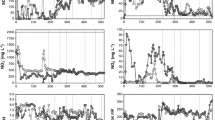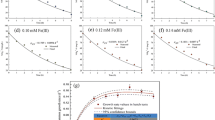Abstract
Introduction
Acidithiobacillus ferrooxidans has a central role in the microbial community metabolism that drives production of acid mine drainage (AMD), a major environmental concern. Metabolomic profiling can offer insight into how At. ferrooxidans contributes to these processes.
Objective
The unique biology of some organisms means that protocols for metabolomic profiling need to be species-specific. Current protocols have largely been optimized for neutrophilic model organisms and, presently, no protocol exists for studying acidophilic extremophiles such as At. ferrooxidans. An appropriate protocol was developed and applied to investigate At. ferrooxidans’ metabolomic capabilities in relation to the colonization of AMD sites.
Methods
We quantified the overall effectiveness of three quenching solutions in combination with three extraction solutions, quantifying the amount of metabolite leakage, number of metabolites extracted and degradation of C13 labeled standards. We then used this method to quantify how the At. ferrooxidans metabolome differed between early and late stages in the logarithmic growth phase to investigate infer how the metabolism of the organism changes as it colonizes the AMD environment.
Results and discussion
An acidic methanol:water based quenching solution with ammonium formate salt used in conjunction with an isopropanol:methanol:water extraction solution produced the smallest amount of leakage, extracted the largest number of metabolites, and was most effective in recovering known standards. When this protocol was applied to the metabolomic fingerprinting of At. ferrooxidans in the beginning and end of its logarithmic growth phase, there was a clear separation in the metabolome at each growth point. Overall, 3% of the metabolome differed significantly.






Similar content being viewed by others
References
Auld, R. R., Mykytczuk, N. C. S., Leduc, L. G., & Merritt, T. J. S. (2017). Seasonal variation in an acid mine drainage microbial community. Canadian Journal of Microbiology, 63, 137–152.
Auld, R. R., Myre, M., Mykytczuk, N. C. S., Leduc, L. G., & Merritt, T. J. S. (2013). Characterization of the microbial acid mine drainage microbial community using culturing and direct sequencing techniques. Journal of Microbiological Methods, 93(2), 108–115.
Baker, B. J., & Banfield, J. F. (2003). Microbial communities in acid mine drainage. FEMS Microbiology Ecology, 44(2), 139–152.
Birkemeyer, C., Luedemann, A., Wagner, C., Erban, A., & Kopka, J. (2005). Metabolome analysis: the potential of in vivo labeling with stable isotopes for metabolite profiling. Trends in Biotechnology, 23(1), 28–33.
Bolten, C. J., & Wittmann, C. (2008). Appropriate sampling for intracellular amino acid analysis in five phylogenetically different yeasts. Biotechnology Letters, 30(11), 1993–2000.
Buziol, S., Bashir, I., Baumeister, A., Claaßen, W., Noisommit-Rizzi, N., Mailinger, W., & Reuss, M. (2002). New bioreactor-coupled rapid stopped-flow sampling technique for measurements of metabolite dynamics on a subsecond time scale. Biotechnology and Bioengineering, 80(6), 632–636.
Canelas, A. B., ten Pierick, A., Ras, C., Seifar, R. M., van Dam, J. C., van Gulik, W. M., & Heijnen, J. J. (2009). Quantitative evaluation of intracellular metabolite extraction techniques for yeast metabolomics. Analytical Chemistry, 81(17), 7379–7389.
Cubbon, S., Antonio, C., Wilson, J., & Thomas-Oates, J. (2010). Metabolomic applications of hilic–lc–ms. Mass Spectrometry Reviews, 29(5), 671–684.
de Koning, W., & van Dam, K. (1992). A method for the determination of changes of glycolytic metabolites in yeast on a subsecond time scale using extraction at neutral pH. Analytical Biochemistry, 204(1), 118–123.
Edwards, K. J., Gihring, T. M., & Banfield, J. F. (1999). Seasonal variations in microbial populations and environmental conditions in an extreme acid mine drainage environment. Applied and Environmental Microbiology, 65(8), 3627–3632.
Faijes, M., Mars, A. E., & Smid, E. J. (2007). Comparison of quenching and extraction methodologies for metabolome analysis of Lactobacillus plantarum. Microbial Cell Factories, 6(1), 1.
Fiehn, O. (2001). Combining genomics, metabolome analysis, and biochemical modelling to understand metabolic networks. Comparative and Functional Genomics, 2(3), 155–168.
Gonzalez, B., François, J., & Renaud, M. (1997). A rapid and reliable method for metabolite extraction in yeast using boiling buffered ethanol. Yeast, 13(14), 1347–1355.
Hoque, M. A., Ushiyama, H., Tomita, M., & Shimizu, K. (2005). Dynamic responses of the intracellular metabolite concentrations of the wild type and pykA mutant Escherichia coli against pulse addition of glucose or NH 3 under those limiting continuous cultures. Biochemical Engineering Journal, 26(1), 38–49.
Karamanev, D. G., Nikolov, L. N., & Mamatarkova, V. (2002). Rapid simultaneous quantitative determination of ferric and ferrous ions in drainage waters and similar solutions. Minerals Engineering, 15(5), 341–346.
Kelly, D. P., & Wood, A. P. (2000). Reclassification of some species of Thiobacillus to the newly designated genera Acidithiobacillus gen. nov., Halothiobacillus gen. nov. and Thermithiobacillus gen. nov. International Journal of Systematic and Evolutionary Microbiology, 50(2), 511–516.
Kim, S., Lee, D. Y., Wohlgemuth, G., Park, H. S., Fiehn, O., & Kim, K. H. (2013). Evaluation and optimization of metabolome sample preparation methods for Saccharomyces cerevisiae. Analytical Chemistry, 85(4), 2169–2176.
Knee, J. M., Rzezniczak, T. Z., Barsch, A., Guo, K. Z., & Merritt, T. J. (2013). A novel ion pairing LC/MS metabolomics protocol for study of a variety of biologically relevant polar metabolites. Journal of Chromatography B, 936, 63–73.
Koek, M. M., Muilwijk, B., van der Werf, M. J., & Hankemeier, T. (2006). Microbial metabolomics with gas chromatography/mass spectrometry. Analytical Chemistry, 78(4), 1272–1281.
Liu, H., Yin, H., Dai, Y., Dai, Z., Liu, Y., Li, Q., Jiang, H., & Liu, X. (2011). The co-culture of Acidithiobacillus ferrooxidans and Acidiphilium acidophilum enhances the growth, iron oxidation, and CO2 fixation. Archives of Microbiology, 193(12), 857–866.
Maharjan, R. P., & Ferenci, T. (2003). Global metabolite analysis: The influence of extraction methodology on metabolome profiles of Escherichia coli. Analytical Biochemistry, 313(1), 145–154.
MEND. (2005). Review of disposal, reprocessing and reuse options for acidic drainage treatment sludge. CANMET, Canada Centre for Mineral and Energy Technology.
Nelson, D. L., Lehninger, A. L., & Cox, M. M. (2008). Lehninger principles of biochemistry. Macmillan.
Oldiges, M., Kunze, M., Degenring, D., Sprenger, G. A., & Takors, R. (2004). Stimulation, monitoring, and analysis of pathway dynamics by metabolic profiling in the aromatic amino acid pathway. Biotechnology Progress, 20(6), 1623–1633.
Oliver, S. G., Winson, M. K., Kell, D. B., & Baganz, F. (1998). Systematic functional analysis of the yeast genome. Trends in Biotechnology, 16(9), 373–378.
Rabinowitz, J. D., & Kimball, E. (2007). Acidic acetonitrile for cellular metabolome extraction from Escherichia coli. Analytical Chemistry, 79(16), 6167–6173.
Schaefer, U., Boos, W., Takors, R., & Weuster-Botz, D. (1999). Automated sampling device for monitoring intracellular metabolite dynamics. Analytical Biochemistry, 270(1), 88–96.
Shin, M. H., Lee, D. Y., Liu, K. H., Fiehn, O., & Kim, K. H. (2010). Evaluation of sampling and extraction methodologies for the global metabolic profiling of Saccharophagus degradans. Analytical Chemistry, 82(15), 6660–6666.
Singer, P. C., & Stumm, W. (1970). Acidic mine drainage: The rate-determining step. Science, 167(3921), 1121–1123.
Southam, G., & Beveridge, T. J. (1992). Enumeration of thiobacilli within pH-neutral and acidic mine tailings and their role in the development of secondary mineral soil. Applied and Environmental Microbiology, 58(6), 1904–1912.
Southam, G., & Beveridge, T. J. (1993). Examination of lipopolysaccharide (O-antigen) populations of Thiobacillus ferrooxidans from two mine tailings. Applied and Environmental Microbiology, 59(5), 1283–1288.
Spura, J., Reimer, L. C., Wieloch, P., Schreiber, K., Buchinger, S., & Schomburg, D. (2009). A method for enzyme quenching in microbial metabolome analysis successfully applied to Gram-positive and Gram-negative bacteria and yeast. Analytical Biochemistry, 394(2), 192–201.
Sumner, L. W., Amberg, A., Barrett, D., Beale, M. H., Beger, R., Daykin, C. A., Fan, T. W. M., Fiehn, O., Goodacre, R., Griffin, J. L., & Hankemeier, T. (2007). Proposed minimum reporting standards for chemical analysis. Metabolomics, 3(3), 211–221.
Temple, K. L., & Colmer, A. R. (1951). The autotrophic oxidation of iron by a new bacterium: Thiobacillus ferrooxidans. Journal of Bacteriology, 62(5), 605.
Tuovinen, O. H., & Kelly, D. P. (1973). Studies on the growth of Thiobacillus ferrooxidans. Archiv für Mikrobiologie, 88(4), 285–298.
Tweeddale, H., Notley-McRobb, L., & Ferenci, T. (1998). Effect of slow growth on metabolism of Escherichia coli, as revealed by global metabolite pool (“metabolome”) analysis. Journal of Bacteriology, 180(19), 5109–5116.
Villas-Bôas, S. G., & Bruheim, P. (2007). Cold glycerol–saline: The promising quenching solution for accurate intracellular metabolite analysis of microbial cells. Analytical Biochemistry, 370(1), 87–97.
Visser, D., van Zuylen, G. A., van Dam, J. C., Oudshoorn, A., Eman, M. R., Ras, C., van Gulik, W. M., Frank, J., van Dedem, G. W., & Heijnen, J. J. (2002). Rapid sampling for analysis of in vivo kinetics using the BioScope: A system for continuous-pulse experiments. Biotechnology and Bioengineering, 79(6), 674–681.
Wang, X., Xie, Y., Gao, P., Zhang, S., Tan, H., Yang, F., Lian, R., Tian, J., & Xu, G. (2014). A metabolomics-based method for studying the effect of yfcC gene in Escherichia coli on metabolism. Analytical Biochemistry, 451, 48–55.
Winder, C. L., Dunn, W. B., Schuler, S., Broadhurst, D., Jarvis, R., Stephens, G. M., & Goodacre, R. (2008). Global metabolic profiling of Escherichia coli cultures: An evaluation of methods for quenching and extraction of intracellular metabolites. Analytical Chemistry, 80(8), 2939–2948.
Wittmann, C., Krömer, J. O., Kiefer, P., Binz, T., & Heinzle, E. (2004). Impact of the cold shock phenomenon on quantification of intracellular metabolites in bacteria. Analytical Biochemistry, 327(1), 135–139.
Xia, J., Mandal, R., Sinelnikov, I. V., Broadhurst, D., & Wishart, D. S. (2012). MetaboAnalyst 2.0—A comprehensive server for metabolomic data analysis. Nucleic Acids Residues, 40, W127–W133
Xia, J., Psychogios, N., Young, N., & Wishart, D. S. (2009). MetaboAnalyst: A web server for metabolomic data analysis and interpretation. Nucleic Acids Residues, 37, W652–W660.
Xu, Y. J., Wang, C., Ho, W. E., & Ong, C. N. (2014). Recent developments and applications of metabolomics in microbiological investigations. Trends in Analytical Chemistry, 56, 37–48.
Zaldivar, J., Borges, A., Johansson, B., Smits, H., Villas-Bôas, S., Nielsen, J., & Olsson, L. (2002). Fermentation performance and intracellular metabolite patterns in laboratory and industrial xylose-fermenting Saccharomyces cerevisiae. Applied Microbiology and Biotechnology, 59(4–5), 436–442.
Acknowledgements
The authors thank Eric Gauthier and Jason Tennessen for reviewing an MSc thesis version of this manuscript.
Funding
This study was funded by Grant 230113 from the Canada Research Chairs Program to Thomas Merritt and a Northern Ontario Heritage Fund Corporation Internship position to Marney Doran.
Author information
Authors and Affiliations
Corresponding author
Ethics declarations
Conflict of interest
All authors declare that they have no conflicts of interest.
Research involving human and animal participants
No animals or humans were used in this research.
Electronic supplementary material
Below is the link to the electronic supplementary material.
11306_2017_1298_MOESM1_ESM.tiff
Supplemental Figure 1: The natural logarithm of the ferric iron concentrations versus time as determined by spectrophotometric analysis of iron production when At. ferrooxidans is grown in TK media. The assumption being that the exponential phase of iron production matches the exponential phase of At. ferrooxidans growth (TIFF 24 KB)
11306_2017_1298_MOESM3_ESM.tiff
Supplemental Figure 3: Mean of technical replicates (n = 3) of cell supernatant and AmFm quenching solution (TIFF 21 KB)
11306_2017_1298_MOESM4_ESM.tiff
Supplemental Figure 4: Mean of the technical replicates (n = 3) of cell supernatant and TK quenching solution (TIFF 20 KB)
11306_2017_1298_MOESM5_ESM.tiff
Supplemental Figure 5: Mean of technical replicates (n = 3) of cell supernatant and physiological saline quenching solution (TIFF 20 KB)
11306_2017_1298_MOESM9_ESM.tiff
Supplemental Figure 9: Mean of technical variation (n = 3) in fourteen 13C labeled standards in three extraction solutions (TIFF 33 KB)
Rights and permissions
About this article
Cite this article
Doran, M.L., Mykytczuk, N., Bieniek, A. et al. Evaluation of quenching and extraction procedures for performing metabolomics in Acidithiobacillus ferrooxidans . Metabolomics 13, 156 (2017). https://doi.org/10.1007/s11306-017-1298-4
Received:
Accepted:
Published:
DOI: https://doi.org/10.1007/s11306-017-1298-4




